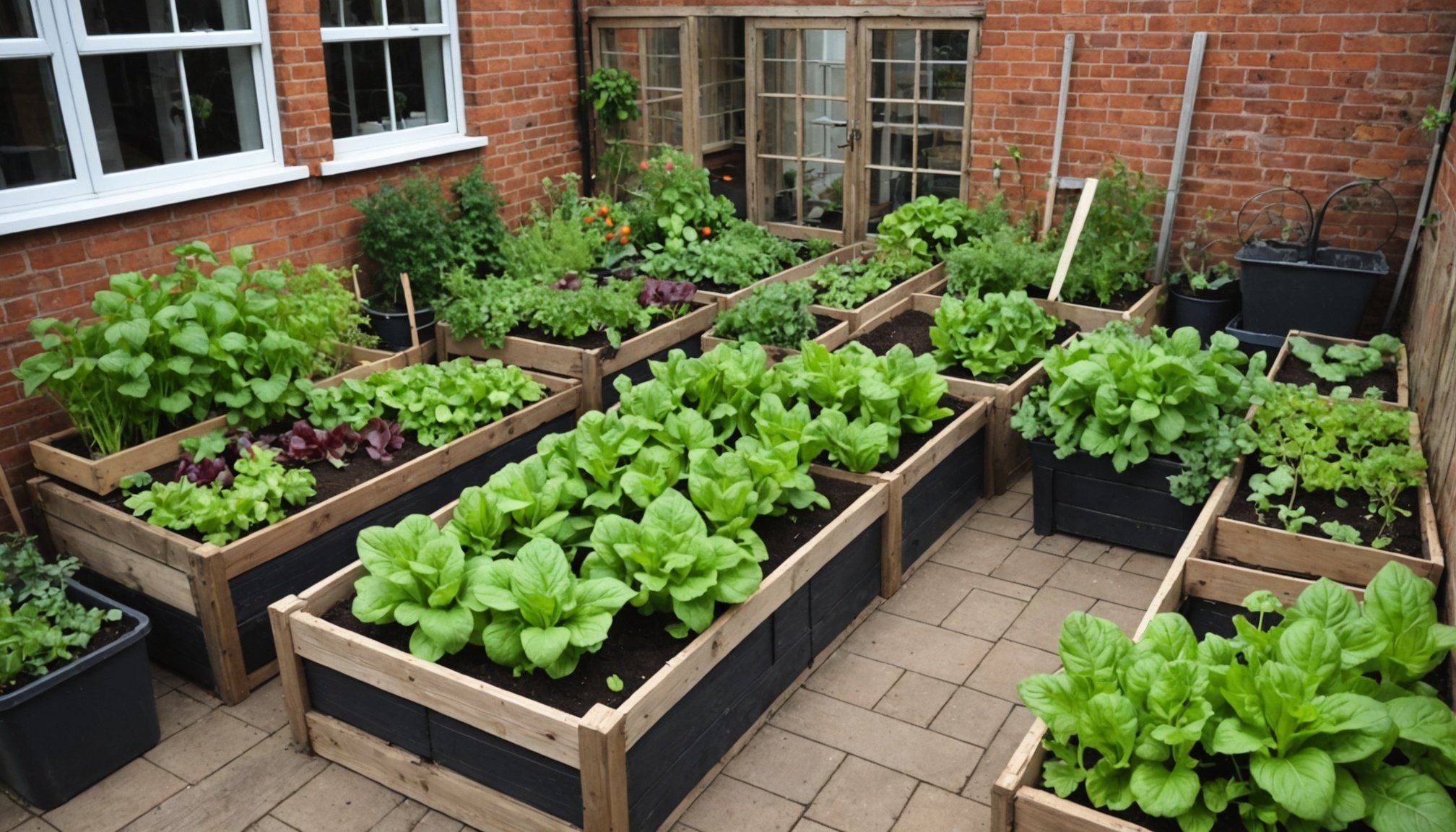Transform Your Tiny UK Urban Space into a Thriving Organic Vegetable Garden: A Step-by-Step Guide
Embracing the Challenge of Urban Gardening
Urban gardening, especially in small UK spaces, can seem daunting, but with the right approach, you can turn even the tiniest of areas into a thriving organic vegetable garden. Whether you have a small balcony, a compact backyard, or just a few windowsills, you can still grow a variety of delicious and healthy vegetables.
Assessing Your Space
Before you begin, it’s crucial to assess your space carefully. Here are a few things to consider:
Also to see : Unlocking the Advantages of Group Fitness Classes: A Guide for Residents in the UK
Light and Shade
- Determine how much sunlight your space receives. Most vegetables need at least 6 hours of direct sunlight per day.
- If your space is shaded, consider using shade-tolerant plants like lettuce, spinach, or herbs.
Soil Quality
- If you have a yard, test the soil to see if it needs any amendments. Urban soils can often be depleted of nutrients.
- For container gardening, choose a high-quality potting mix specifically designed for vegetables.
Wind and Temperature
- Urban areas can be windy, so consider using windbreaks or choosing plants that are less susceptible to wind damage.
- Be aware of the temperature fluctuations in your area and choose plants that are hardy enough to withstand them.
Choosing the Right Plants
Not all vegetables are created equal when it comes to small spaces. Here are some easy-to-grow options that thrive in urban environments:
Best Vegetables for Small Spaces
- Leafy Greens: Lettuce, spinach, kale, and arugula are perfect for small spaces and can be grown in containers or directly in the ground.
- Herbs: Basil, mint, cilantro, and parsley are great for adding flavor to your dishes and can be grown in small pots or even on windowsills.
- Cherry Tomatoes: These are compact, produce fruit quickly, and can be grown in hanging baskets or small raised beds.
- Radishes: They grow quickly and can be harvested in as little as 20 days, making them ideal for small spaces.
- Carrots: While they require deeper soil, there are varieties like ‘Parisienne’ or ‘Thumbelina’ that are designed for shallow soils.
Creating Your Garden
Raised Beds
Raised beds are an excellent option for urban gardening. Here’s why:
In parallel : Top Noise-Canceling Headphones Every UK Commuter Should Consider for a Stress-Free Journey
| Advantages | Description |
|---|---|
| Better Drainage | Raised beds allow for better soil drainage, reducing the risk of waterlogged soil. |
| Warmer Soil | The soil in raised beds warms up faster in the spring, giving your plants a head start. |
| Improved Accessibility | Raised beds are easier to maintain, as you don’t have to bend down as much. |
| Pest Control | Raised beds can help keep pests like slugs and snails away from your plants. |
To create a raised bed, you can use wooden planks, bricks, or even recycled materials like old pallets.
Container Gardening
If you don’t have ground space, container gardening is a great alternative.
Tips for Container Gardening
- Use Large Containers: Choose containers that are at least 6-8 inches deep to give your plants enough room to grow.
- Good Drainage: Ensure your containers have good drainage holes to prevent waterlogged soil.
- High-Quality Potting Mix: Use a potting mix specifically designed for containers, as it will retain moisture but also drain well.
- Frequent Watering: Containers dry out faster than ground soil, so make sure to water your plants regularly.
Vertical Gardening
For the smallest of spaces, vertical gardening can be a game-changer.
How to Set Up a Vertical Garden
- Use a Trellis or Wall Planter: You can use trellises, wall planters, or even a DIY setup using a wooden board and some pockets.
- Choose Climbing Plants: Plants like peas, beans, and cucumbers are perfect for vertical gardens.
- Maintain Proper Spacing: Ensure that your plants have enough space to grow and receive adequate sunlight.
Preparing the Soil
Healthy soil is the foundation of a thriving garden. Here are some steps to prepare your soil:
Testing Your Soil
- Use a soil testing kit to determine the pH level and nutrient content of your soil.
- Based on the results, add necessary amendments like compost, manure, or fertilizers.
Adding Organic Matter
- Compost is a great way to enrich your soil. You can make your own compost using kitchen scraps and yard waste.
- Incorporate organic matter like peat moss or well-rotted manure to improve soil structure and fertility.
Planting Your Garden
Once your space and soil are ready, it’s time to start planting.
Planting Tips
- Follow Seed Package Instructions: Different plants have different planting depths and spacings.
- Water Thoroughly: Water your plants well after planting and keep the soil consistently moist during the first few weeks.
- Mulch Around Plants: Mulching helps retain moisture, suppress weeds, and regulate soil temperature.
Maintaining Your Garden
Maintenance is key to keeping your garden healthy and productive.
Watering
- Water Deeply but Infrequently: Encourage deep root growth by watering your plants deeply but less frequently.
- Avoid Overwatering: Check the soil moisture by inserting your finger into the soil up to the knuckle. If the soil feels dry, it’s time to water.
Fertilizing
- Use Organic Fertilizers: Organic fertilizers like compost tea or fish emulsion are gentle on the soil and provide slow-release nutrients.
- Companion Planting: Some plants, like marigolds and nasturtiums, repel pests and can be used as natural fertilizers.
Pest and Disease Management
- Inspect Your Plants Regularly: Keep an eye out for signs of pests or diseases.
- Use Natural Pest Control Methods: Encourage beneficial insects, use neem oil, or spray soapy water to control pests.
Enjoying Your Harvest
The best part of gardening is enjoying the fruits of your labor.
Tips for Harvesting
- Harvest at the Right Time: Different vegetables have optimal harvesting times. For example, leafy greens can be harvested as soon as they are large enough to eat, while tomatoes should be picked when they are fully ripe.
- Use Fresh: Use your fresh produce immediately for the best flavor and nutrition.
Transforming your tiny UK urban space into a thriving organic vegetable garden is not only possible but also highly rewarding. With the right plants, proper soil preparation, and regular maintenance, you can enjoy a bountiful harvest right in the heart of the city.
As Leigh Clapp, an urban gardening expert, once said, “The key to successful urban gardening is to make the most of the space you have. Whether it’s a small balcony or a compact backyard, every inch can be used to grow something delicious and healthy.”
So, don’t let the limitations of your space deter you. Start small, be patient, and watch your urban garden flourish.
Additional Resources
Detailed Bullet Point List: Steps to Create a Raised Bed
- Plan Your Raised Bed:
- Decide on the size and location of your raised bed.
- Ensure it receives adequate sunlight.
- Gather Materials:
- Wooden planks or bricks for the frame.
- Soil and compost for filling.
- Tools like a shovel, trowel, and hammer.
- Build the Frame:
- Assemble the frame using your chosen materials.
- Ensure it is level and secure.
- Fill with Soil:
- Mix in compost and other amendments as needed.
- Fill the bed to the top, leaving a small gap for watering.
- Plant Your Vegetables:
- Follow the planting instructions for each type of vegetable.
- Water thoroughly after planting.
Comprehensive Table: Comparison of Gardening Methods
| Gardening Method | Advantages | Disadvantages | Best For |
|---|---|---|---|
| Raised Beds | Better drainage, warmer soil, improved accessibility | Requires initial setup, can be expensive | Small yards, poor soil quality |
| Container Gardening | Flexible, good for small spaces, easy to maintain | Containers dry out quickly, limited root depth | Balconies, patios, small spaces |
| Vertical Gardening | Maximizes space, visually appealing | Requires support structures, can be labor-intensive | Small spaces, urban areas |
Relevant Quotes
- “Happiness, not in another place but this place…not for another hour but this hour.” – Walt Whitman, emphasizing the joy of gardening in the present moment.
- “The key to successful urban gardening is to make the most of the space you have.” – Leigh Clapp, highlighting the importance of optimizing space in urban gardening.
By following these steps and tips, you can create a thriving organic vegetable garden even in the smallest of urban spaces, enjoying the satisfaction of growing your own food and connecting with nature right in the heart of the city.











